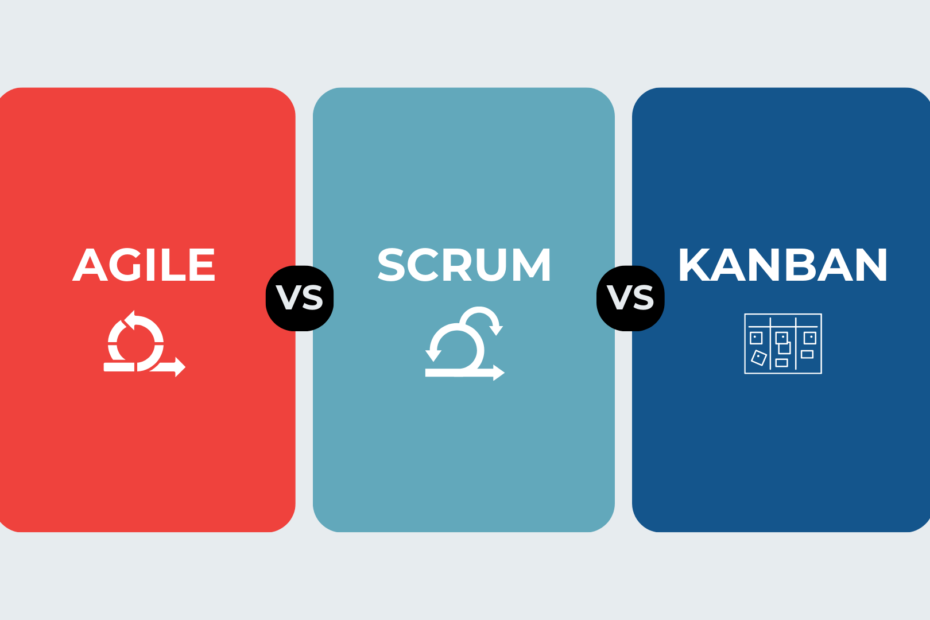Organizations are always looking for methods that will enable them to produce better goods more quickly in the fast-paced world of modern product development. These days, the most popular frameworks for promoting productivity, flexibility, and teamwork are agile, scrum, and kanban. Although these approaches are frequently discussed collectively, each has a distinct function and can be applied in a variety of ways based on the demands of product development.
We’ll discuss the differences, similarities, and best practices of Agile, Scrum, and Kanban in this blog, as well as how each supports effective product management.
Understanding Agile: The Umbrella Framework
Agile is not a specific methodology, but rather a set of principles and values aimed at delivering value incrementally, responding to change, and fostering collaboration. It is based on the Agile Manifesto and prioritizes user feedback, continuous improvement, and adaptability to changes.
Agile is especially useful in the context of product development since it enables teams to concentrate on iterative releases, guaranteeing that the product changes in accordance with market trends and user needs. Agile encourages teams to prioritize tasks based on their business value, divide up large projects into smaller portions, and iteratively improve them in response to feedback.
Core Values of Agile:
- Individuals and interactions over processes and tools
- Working software over comprehensive documentation
- Customer collaboration over contract negotiation
- Responding to change by following a plan
Scrum: A Structured Framework within Agile
Scrum is a popular Agile framework that facilitates teams working in short, concentrated productivity bursts called sprints. The team delivers a potentially shippable product increment at the conclusion of each sprint, which usually lasts between one and four weeks. Scrum keeps the team in line with corporate goals while encouraging transparency, accountability, and adaptability.
Key Components of Scrum:
- Roles – Scrum teams consist of three key roles:
- Product Owner (responsible for defining the product backlog and prioritizing work),
- Scrum Master (ensures that Scrum processes are followed and removes impediments),
- Development Team (the cross-functional team responsible for delivering the work).
- Artifacts
- Product Backlog (a list of everything that needs to be done),
- Sprint Backlog (a subset of the product backlog for the current sprint),
- Increment (the working product produced during the sprint).
- Events – Scrum relies on five key events:
- Sprint Planning,
- Daily Scrum,
- Sprint Review,
- Sprint Retrospective,
- and of course, the Sprint itself.
Scrum works well for projects that need a methodical approach to decomposing complicated jobs so that teams may concentrate on completing particular features within a set amount of time.
Kanban: A Visual Approach to Workflow Management
Another Agile approach is Kanban, which emphasizes visualizing the workflow and is more adaptable than Scrum. Teams that require flexibility and continuous flow as opposed to batch delivery should consider Kanban, as its teams strive to deliver continually without the time constraints associated with sprints.
The main component is the Kanban Board, where tasks are organized into three stages of completion: “To Do,” “In Progress,” and “Done.” Teams limit the number of tasks that can be in progress at any given moment (Work-In-Progress or WIP limitations) to prevent bottlenecks and ensure continuous, constant output.
Key Principles of Kanban:
- Visualize the Workflow – Use the Kanban board to display every task and its current status.
- Limit Work in Progress (WIP) – Define how many tasks can be worked on simultaneously to avoid overwhelming the team.
- Focus on Flow – Strive for a smooth flow of work, ensuring that tasks are continuously moving through the system.
- Continuous Improvement – Kanban emphasizes making incremental improvements to the process as the team learns what works best.
Kanban is often favored by teams that deal with unpredictable work volumes or need the flexibility to reprioritize tasks on the fly. While it’s widely utilized in operations and support teams, product development is starting to use it more and more to handle continuous delivery.
Agile, Scrum, and Kanban: Which One is Right for Your Team?
Choosing between Agile, Scrum, and Kanban depends largely on the nature of your product development process, the team’s dynamics, and the project’s complexity.
When to Use Scrum:
- Projects that need clear structure and deadlines.
- Teams that benefit from defined roles and ceremonies.
- When there is a need for frequent, tangible deliverables.
When to Use Kanban:
- Projects where work needs to flow continuously rather than being time-boxed.
- Teams that face frequent interruptions or unpredictable tasks (e.g., customer support).
- Organizations looking for a lighter framework with fewer meetings.
When to Use Agile (Broadly):
- In situations where flexibility, rapid iterations, and customer feedback are critical.
- When cross-functional collaboration and adaptability are key to success.

Many organizations find that combining Scrum with Kanban sometimes referred to as Scrumban, gives the best of both worlds. Teams may leverage the flexibility of Kanban and the structure of Scrum with this hybrid method, which strikes a balance between short-term delivery and long-term vision.
The efficacy of Agile, Scrum, and Kanban frameworks for enhancing product development processes varies depending on the requirements of your team and project. Agile provides overarching principles, while Scrum offers a structured approach, and Kanban focuses on flexible, continuous workflow.
Product managers can more effectively lead their teams toward successful, effective, and responsive product development by being aware of the advantages of each technique. Every framework has a role in the process from concept to delivery, regardless of whether you require the flexibility of Kanban, the discipline of Scrum, or the philosophy of Agile.
